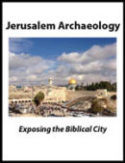Nearly 2,000 years ago, a young girl was laid to rest in a tomb on what is today Jerusalem’s Mount Scopus. She was buried inside a lead coffin with a trove of gold jewelry, possibly intended to protect her in the afterlife, which archaeologists with the Israel Antiquities Authority (IAA) are just beginning to investigate.

Jerusalem, Aelia Capitolina, and the Cult of Luna
Among the items found within the girl’s coffin were golden earrings, a hairpin, gold, carnelian, and glass beads, and, most remarkably, a gold chain bearing a lunula pendant, named after the Roman moon goddess Luna. The burial dates to the later part of the Roman period when, following the Roman destruction of Jerusalem in 70 CE, the city was rebuilt and renamed Aelia Capitolina. During this period, people from all over the Roman Empire came to settle in the city. They brought with them new cultures, traditions, and religions, including the popular cult of the goddess Luna.
“These items of jewelry are known in the Roman world, and are characteristic of young girl burials, possibly providing evidence of the people who were buried at these sites,” said IAA experts Ayelet Dayan, Ayelet Gruber, and Yuval Baruch in a statement. According to them, the valuable lunula pendant likely served as a protective talisman during the girl’s lifetime and was included with her burial to protect her in the afterlife. Similar finds dated to the same period have also been found on the Mount of Olives.
According to Eli Eskozido, Director-General of the IAA, “The interring of the jewelry together with the young girl is touching. One can imagine that their parents or relatives parted from the girl, either adorned with the jewelry or possibly lying by her side and thinking of the protection that the jewelry provided in the world to come. This is a very human situation, and all can identify with the need to protect one’s offspring, whatever the culture or the period.”
The young girl’s tomb was excavated over 50 years ago by the IAA, then called the Israel Department of Antiquities and Museums. However, once the original excavator died, its contents went unstudied and unpublished. This has been a common problem within Israeli archaeology and around the world. Now, the IAA has launched its “Publication of Past Excavations Project” to address this problem. Through the project, old unpublished excavations are being reexamined and then made available to scholars and the public.
“The location of the original reports that gathered dust over the years in the Israel Antiquities Authority archives, and physically tracing the whereabouts of the items themselves, has shed light on long-forgotten treasures,” said Dayan, who is heading the project. “The beautiful jewelry that we researched is an example of such treasures.”
Read more in BHD:
All-Access members, read more in the BAS Library:
Jerusalem and the Holy Land(fill)
Jerusalem in David and Solomon’s Time
Not a BAS Library or All-Access Member yet? Join today.The post Jerusalem’s Golden Tomb appeared first on Biblical Archaeology Society.





0 Commentaires